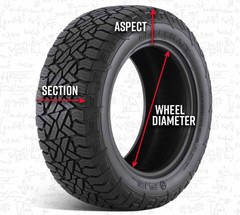Posted by R Bass on 20th Oct 2024
Metric Tire Calculator
Understanding the Metric Tire Conversion Chart: A Must-Have for Off-Road Enthusiasts
When it comes to upgrading your off-road rig, one of the most important decisions you’ll face is selecting the right tires. For off-road vehicles, tires are more than just a way to get from point A to point B—they’re your primary contact with the terrain, providing the grip, durability, and traction needed for everything from rocky trails to muddy backroads. But with so many tire specifications out there, especially when it comes to metric sizes, choosing the right one can get confusing fast.
That’s where a Metric Tire Conversion Chart comes in handy for every off-road enthusiast. Metric tire sizes follow a specific formula, which can seem a bit perplexing if you’re more accustomed to dealing with standard, inch-based measurements. For example, a tire labeled as **275/70R18** might sound like a foreign language at first. But breaking it down is simple once you know how the numbers and letters work. The first number (275 in this case) refers to the tire’s width in millimeters, the second number (70) is the aspect ratio, which indicates how tall the tire sidewall is as a percentage of the width. The "R" denotes that the tire is of radial construction, and the final number (18) is the diameter of the wheel it fits, measured in inches.
Knowing how to read a tire’s metric sizing system is just the first step. The real challenge comes when you need to swap tires that may not exactly match your vehicle’s original specs. This is where the conversion chart is essential. By using a metric tire conversion chart, you can easily translate between metric and standard sizes, making it easier to find a compatible tire for your off-road adventures. For example, if you’re switching from a standard 33-inch tire to a metric size, the conversion chart will help you find the equivalent size in millimeters. This ensures that you maintain proper clearance, load capacity, and performance when upgrading your tires.
Another key reason to use a metric tire conversion chart is to avoid issues with speedometers, odometers, and even handling. Tires affect everything from how your vehicle accelerates to how it grips in different terrains. Using a size that’s too large or too small can throw off your vehicle’s balance and even affect safety. The right tire ensures that your vehicle operates within its designed specifications, and a conversion chart can make sure that your new tires are the perfect fit for your vehicle.
At **Down East Offroad**, we know how important it is to get the right tires for the job, especially when tackling challenging off-road conditions. Having a metric tire conversion chart handy is a simple but crucial tool that helps you make informed decisions when upgrading your rig. Whether you’re looking to swap out the stock tires or go big with a more aggressive set, understanding how metric sizes work—and using the conversion chart—is key to ensuring your vehicle performs at its best. So, next time you're in the market for new tires, don’t leave home without it!

